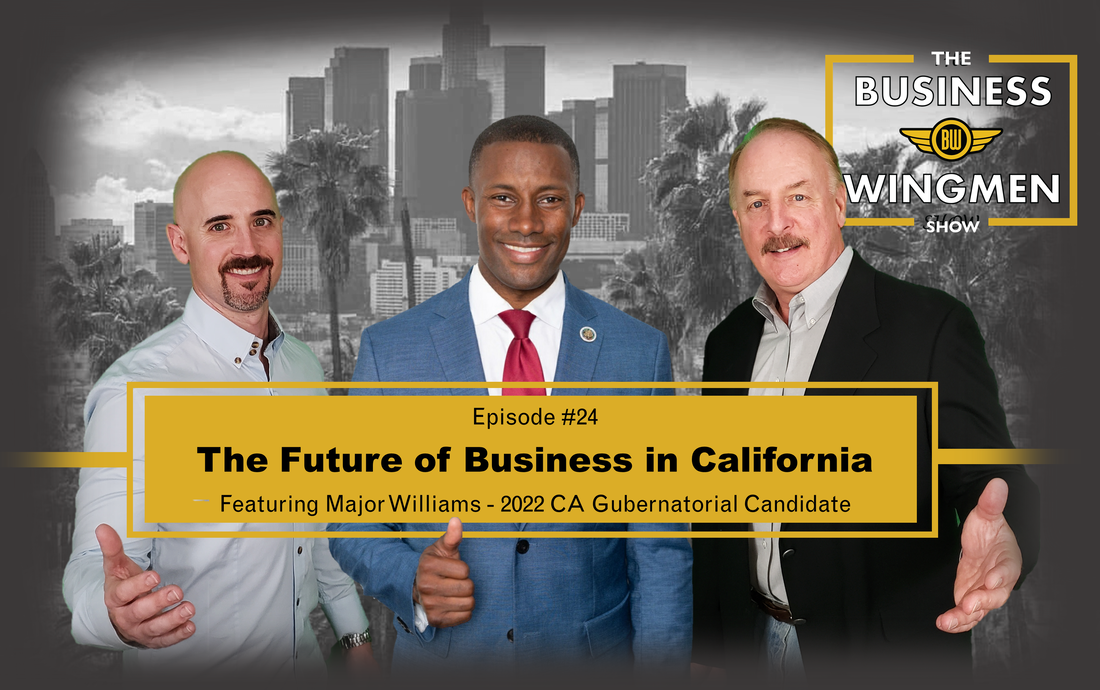|
Medtech Snapshot presents Rodney Brenneman, medtech start-up exec, who shares his winning strategy on what is needed from a leadership perspective in order to propel a pre-clinical company forward.
Hear how emotional intelligence, adaptability and long-term strategies make the difference! If you're enjoying these Medtech Snapshots, be sure to check out our archives of past episodes HERE. #medtech #snapshot #podcast #medicaldevice #startup #entrepreneur #strategy #commercialization #emotionalintelligence #EQ #leadership
0 Comments
In this episode we cover Medical Device Management Top Grading tips with Peter Nalbach, VP & GM, in Orange County, CA. Listen in as Pete outlines his 3-step process to align and bring in the right people to help move the company forward while simultaneously overcoming product challenges throughout the lifecycle process.
#management #medtech #medicaldevice #people #topgrading #leadership #snapshot The Future of Business in California3/30/2021 TODAY AT 4 PM pacific!
Business owners of all industries and sizes have had to battle many challenges over the last year; pandemic, economic, societal, technological and political, just to name a few. All of these challenges have served up their own unique obstacles to deal with. The hosts of Business Wingmen Podcast Show Steve and Travis host a special guest, Major Williams, who will talk about today's business climate and his vision for the future of business in California. Join us to meet Major Williams - a seasoned entrepreneur, business owner and now candidate of Governor of California! Listen in on the discussion at www.businesswingmen.com #podcast #business #california #majorwilliams #economy #future #leadership #businesswingmen Executive Summary: The world of startups and small business can indeed be an exciting place to be. Its commonly characterized as highly collaborative, fast pace, less bureaucratic and wildly innovative. While this sounds great in theory, in practice the world of a startup can be rife with challenge, including heavy amounts of stress and uncertainty. It’s vital we as professionals analyze our personalities and professional behaviors to assess whether or not we would do well in the startup world - before we actually jump in. Knowing what you’re up against before you dive in will allow you to determine if it’s appropriate for you to consider the startup space, small business and or entrepreneurship. Author: Travis Smith Read the full article by downloading the below PDF attachment
Growth in hiring is typically a good thing. Why thank you Captain Obvious. While growth in hiring may very well be a good thing, successfully navigating the hiring process is an entirely different story.
Successful hiring can make or break the performance of a company. Unsuccessful hiring on the other hand creates all sorts of fun challenges for folks like you and me. In fact, Harvard Business Review identifies 80% of employee turnover is due to bad hiring decisions. What does this mean? First, let’s look at the potential tangible repercussions. According to Dice, one of the larger online job boards, a poor hiring decision for a candidate earning $100,000 per year could cost, on average, $250,000, and that expense comes right off the bottom line. That’s scary stuff! Basically, if the hiring decision you made ends poorly you can expect that mistake to represent 2.5 times the cost of whatever the salary is of the person you are hired. Rather than fearing the hiring process, or having it work against us, we should approach it with a strategic and open minded process to ensure success. Want to improve your hiring practices? Employee (pun intended) these 15 tips: 1. Why Would Someone Pick You/ Your Company? No longer is it realistic for employers to have the notion that just because you are in the drivers’ seat administering the interview means you have all the power. In fact, it’s quite the opposite as the current market is more in favor of the job seeker as they have plenty of options to choose from, you being one of them. If you want the best of the best you have to be able to speak to WHY people should consider you and your company. Your story must resonate with your interviewees. 2. Character Over Competency The best leaders use this philosophy – hire people who will bleed for your cause and will make the right decisions even in the darkest of hours. Competency in most jobs can be taught, character is what the person has developed well before you came around so don’t think you can change it easily, if at all 3. Behavioral Based Interviewing A great tactic while interviewing is to ask people what they would do in certain situations. This causes people to have to think and adjust in the moment. You aren’t trying to catch someone doing something wrong here, more or less understand their thought process and how they handle certain tasks or situations 4. Know What You Want Before You Interview All too often I hear people say, “we need to interview some people first to better understand who we are looking for”. You should never need to interview someone in order to help you understand who or what you are looking for. If you use this practice most often what it means is you don’t know what you’re doing from a leadership perspective. Tough love I know but it’s highly important you know what you want and need before you go looking for it during interviews. Wasting people’s time so you can figure out your direction with hiring isn’t advisable and it’s unprofessional. 5. Consult Others Before you go about the interview process speak with other managers about their experiences and your plans for your hiring process. The best advice typically comes from those who have been there and done it before that way you can learn from their successes and mistakes 6. Make Sure You Know And Understand Your Vision Somewhat similar to number #1 however this focuses on you and your specific team. Put yourself in the shoes of the person interviewing and think “Why would I want to work for her/ him?” “Does this vision excite me?” “What is my role in the future of this company?” 7. Best Foot Forward A helpful reminder if nothing else, remember when people are interviewing you are witnessing their ideal self, seeing them at their best. Asking questions which will give you better insight into who they are day-to-day, not just during your interview, are always good ways to get a better glimpse into who they are in a very day setting. 8. Tell Them Your Leadership Philosophy This is especially important if you are hiring the person to join your team. This is also very different than #6 which talks about the vision for your team or company. Here you are sharing with your interviewee how you lead and what you believe in. A great precursor question to this is asking the candidate what type of leadership they like and want in their next career 9. Interview Tests It’s a great practice to test candidates on their abilities on the spot, so long as the test is directly relatable to their core job function. If you are interviewing a Mechanical Engineer, for example, it is highly suggested you test them on the exact work they would be doing for you (ie Solidworks modeling) 10. The Reference Trick I personally think references are a waste of time. Why? Because the people on the other end of the phone are doing nothing but singing the praises of the person you are interviewing. In over a decade I can name on one hand the number of reference checks I’ve performed which brought about a poor review. Here’s how to get around it – when you are on the phone with the reference which was provided by your interviewee ask who else the interviewee worked with and then try to phone that person. This person won’t be prepared for your call and may provide you with more realistic insight into the persons’ work ethic and behaviors. 11. Put Yourself In Their Shoes Interviewing isn’t easy. In fact it can be downright terrifying for some people. Try looking beyond the interview. Just because someone’s interview isn’t a glowing success, or they may seem overly nervous, doesn’t mean they aren’t a good catch. Just because someone interviews well doesn’t mean they will perform well in the job. 12. Job Description = Performance Expectations It’s time we ditch the HR job descriptions and actually write and talk about what the newly hired employee will be expected to do from a performance perspective. If you’re hiring for sales, interview your candidates based on the quotas and metrics you’ll have in place. Ask how they will achieve those goals, what their strategies will be, etc. 13. Know Your Non-Negotiables What are you not willing to tolerate? When I’m in a position of hiring my two non-negotiables are attitude and integrity because both of these are things we have 100% control over. Knowing that I then ask questions around those two to see how they view my perspective on my non-negotiables. Asking interviewees their non-negotiables will also give you an idea of where their priorities land 14. Challenge Your Own Mindset One of the most common mistakes leaders make when hiring is they select candidates that remind them of themselves or select candidates that are beneath them skill wise. Great leaders surround themselves with people who are not only competent but will challenge the leader to be better. 15. Don’t Hire If It Isn’t What You Want I hired an employee that was most of what I was looking for but through the interview I uncovered some things that were less than great. Up to this point I had interviewed so many people that I just decided to move forward with this particular candidate and did the whole ‘cross your fingers’ bit in hopes they would work out. From that experience I can tell you it is always better to not hire when in doubt than hire because you need to fill a spot. I recently finished reading a powerful book called ‘The Dichotomy of Leadership’ which is a follow up to the number one best selling book ‘Extreme Ownership’ by Jocko Willink and Leif Babin. The authors who happen to be highly decorated Navy SEALS share their inspiring and at times scary tales on the battlefield, relating how those experiences blend with real world business and board room leadership challenges.
The book ‘The Dichotomy of Leadership’ struck a cord with me as I’ve struggled over the years with the balancing act which takes place in leadership. This balancing act, or dichotomy, is an ever present daily tug of war often between two extremes which are intrinsically linked yet incredibly challenging to consistently toe the line successfully. Dichotomy itself is an interesting word rife with conflict. Dichotomy is defined as a contrast between two things that are, or are represented as being, opposed or entirely different. (ie – in leadership there is the push and pull of how friendly you become with your employees – too friendly and you lose their respect and or ability to make tough decisions, whereas not being friendly enough alienates you as a leader and keeps you from knowing your people) As I’m reading this book one of the dichotomies the authors spoke about which is a consistent challenge for leaders is the contrast between leading and following. There’s a strong misconception in the world of leadership which aligns with the idea that if you’re in a leadership role you must always be leading. Decisions should be made by those in leadership, strategies engineered and dreamed up by those in leadership. This of course is an ego-centric mentality and quite frankly one which is incredibly out of date in todays’ business world. Yet this same idea, leaders must always be leading, permeates every facet of business in most companies we encounter on a daily basis. My awakening as a result of this book came about as a result of my own shortcomings, and yes ego, as a leader. I too thought, “As a leader it’s up to me to decide the direction we’re taking and therefore the decisions we’re making.” Unfortunately this thought process is incredibly short sided. The true nature of a good leader, as the book artfully describes, is a person who understands they can be in a leadership role and simultaneously lead while following. Sounds strange at first yet it’s possible, more importantly it’s highly impactful in an organization. The act of a leader willingly following sends a powerful message to the leaders team and company that they are out to do what is best and necessary for the greater good, not just themselves as the leader. Here’s how following as a leader plays out. A CEO of XYZ company has a tough decision to make when it comes to the direction of her company and the potential new markets they’re looking to develop. Traditional leadership has dictated the senior most person, often times the CEO, makes the decisions for the company. They may collect information from their subordinates on options or alternatives to consider however the senior most leader is the one to make the decision based on as their position and respective authority demands they be the one to blaze the path forward. However, a leader who possesses the ability to balance the dichotomy of leading and following can recognize that while they are in a leadership seat it doesn’t mean they always must be leading. Sometimes following can produce more impactful results. It also means these leaders are able to recognize their ego and set it aside for the betterment of the company. Going back to our CEO of XYZ company, as she’s considering where to take the company into the future she may get advice from an employee in the company which provides a great opportunity for growth and future success. Leaders who are successful in balancing leading and following would then lean on that employee to drive said initiative recognizing what’s important isn’t where the good idea comes from just that it is implemented successfully. Our leader, rather than leading, makes a conscious decision to follow and allows the employee to step up with their idea and help lead the company through it. They empower the other person while giving them an opportunity to shine. The leader, in this case our CEO, allows their employee to receive the credit for the idea while also helping them to get it up and running. Our CEO is now following and doing so because they know this decision is what is best for the business. Key Take Away: One of the most challenging things to balance as a leader is knowing when to lead versus when to following. Leaders who lead all the time lose sight of what is best for their company while also struggling with humility to give others the opportunity to shine. When we step aside and follow as a leader we encourage others to deploy their ideas while creating a vacuum for our employees and peers to step up, offer suggestions while increasing their likelihood to take additional ownership in their work. Leaders must recognize their ego drives many of their decisions and actions, one of the best decisions we can make is acknowledge our ego and set it aside to make room for others to take the wheel while we encourage them to do so. Action Item: If you struggle with the balancing act which comes with leadership, in particular the area of ‘leading versus following’ I highly suggest picking up the book ‘The Dichotomy of Leadership’ by Willink and Babin. The nuggets of knowledge, insight and real world practical examples these two authors share more than once will open your eyes to new and alternative approaches to successful leadership. Leadership is one of the hardest things a person can do professionally. There’s no manual, no playbook, no cliff notes that give leaders the ‘secret sauce’ to successfully lead the charge. Sure there are thousands of avenues one could go to learn more about leadership however at the end of the day it’s still a job that mainly rests on intangible actions like care, empathy, intuition and respect for the very people leaders serve. Leading is often described as a lonely experience. Elisabeth Elliott, a famous author, speaker and missionary once said “Loneliness is a required course for leadership.” The feeling of loneliness at the top is much more common than most of us realize as more than 50% of leaders indicate they have experienced loneliness at one point or another in their career. The stats are even higher for first time leaders at a whopping 70%. When leaders experience solitary the impacts can be devastating. Isolation and loneliness have a direct negative affect on a leaders’ performance which then directly impacts their employees, departments, business units and companies. How is it then leaders find themselves down in the dumps on lonely island? Some of the most common causes are: 1. Forced Isolation- Leaders seclude themselves from the rest of the group by working in an office which can create imaginary barriers between them and their staff. Closing the door actually creates a real barrier that communicates “I’m not available and don’t have time for you”. Regardless if this isolation was intentional or unintentional it produces the same results where the leaders’ staff hesitate to communicate with their boss, or not at all. 2. Decision Making- In most businesses decision making is typically left to the people carrying the torch. When decisions go well all is good in the world yet when decisions produce less then spectacular results the leader is left out in the cold to take the brunt of the responsibility. It’s part of the job but it can also produce isolation at a whole new level which isn’t typically understood or felt by the company’s employees. 3. Don’t Ask For Help- Many times isolation is self-inflicted as leaders don’t ask for help from their teams or peers. There’s an unspoken feeling for many leaders which goes something like, “they expect me to know everything because that’s what I get paid for and why I’m in the job”. Thoughts like this can be incredibly damaging and certainly have no justifiable basis for being correct or healthy. 4. Lack Humility- When leaders act in a way which broadcasts ‘I’m more important than you because I’m in a leadership role’ employees quickly disengage, refraining from putting effort in to build relationships with their leaders or working hard on their behalf. When leaders act this way many times it can be attributed to ego or overcompensating for a lack of confidence. 5. Poor Treatment of Others- One of the quickest ways a leader can find themselves on lonely island is by treating their employees or staff in a poor manner. They lack emotional intelligence. (EQ) When employees feel like they aren’t valued or respected they withdraw which commonly leads to limited interaction and feedback with leadership. The result is a drift occurs in the organization between what leadership wants and what employees are doing. Let’s be clear here, we aren’t about to throw a pity party for our leaders. They’re grown ups right, big boys and big girls who have made the choice to enter leadership on their own accord. So if they’re feeling isolated or lonely than it’s by their own doing, right? Not necessarily. While we’d all love to think the statement above is accurate the reality is that employees do in fact have some ownership in the leadership isolation situation. Employees have a unique ability to see things their leaders don’t, hear things their leaders don’t and help in situations where their leaders would otherwise be clueless about. These five options when implemented help to foster an environment of support and mutual respect, one in which both leader and employee benefits from:
When leaders and employees work together and support one another it significantly reduces the likelihood people of any kind will experience isolation. “There is no respect for others without humility in one's self.” - Henri Frederic Amiel Key Take Away: If you’re feeling lonely as a leader chances are it’s a result of your own doing. Sorry to hit you with the brutal honesty. Loneliness in leadership impacts more people than just yourself. One of the best ways to overcome it is to join a peer group or get a leadership mentor/ coach. Action Item: Feeling like you’re on lonely island right about now? Select two people from your company, one of which needs to be a direct report, and ask them for their candid feedback. Start by telling them how you’re feeling and your desire to do something about it. Get vulnerable and ask for their help while creating an environment where people feel comfortable telling you how they perceive you and your presence as a leader. After you receive the feedback – SHUT UP! Don’t argue about it, don’t disagree. Just listen, observe and take it all in. Thank the person for their feedback and take the rest of the day to smolder on it. With time and patience, you will begin to open yourself up to hearing other people’s perspectives while learning how to take their words and incorporate it into a new you. Now, go get em, champ! What’s the difference between a great leader and an average one?
I’ve had the opportunity to observe dozens of leaders in my career. Some were exceptional, most barely passed for average. I’ve spent many hours tossing and turning on the idea of what makes for an exceptional leader, what makes them great. I’ve read books, had discussions with colleagues, watched videos and talked with people who are far smarter and experienced than myself. After all of this wonderful introspection and discovery one characteristic continues to pop up which defines great leadership over average leadership. It’s a mindset, a willingness to do what others often won’t. What makes great leaders is their ability and willingness to use ‘managerial courage’. Managerial courage is the linchpin, the cornerstone, the apex for all things related to leading successfully. The word courage is of itself is an incredibly powerful word. The late John McCain had described courage as “that rare moment of unity between conscience, fear, and action, when something deep within us strikes the flint of love, of honor, of duty, to make the spark that fires our resolve.” Bill George, former CEO of Medtronic and best selling author is quoted as saying “Courage is the quality that distinguishes great leaders from excellent managers.” George also said, “courageous leaders take risks that go against the grain of their organizations. They make decisions with the potential for revolutionary change in their markets. Their boldness inspires their teams, energizes customers, and positions their companies as leaders in societal change.” If we apply George’s and McCain’s definitions of courage we can surmise that ‘managerial courage’ is the willingness to make decisions which we believe to be in the best interest or our employees or company, regardless of the popularity or risks involved. A deeper look into managerial courage and we find that it can be further described as a set of actions and beliefs a leader possesses which define who they are and how they go about leading and inspiring others. These actions and beliefs include:
There’s no other word I can think of other than ‘courage’ to appropriately define good leadership. Primarily because it is so easy to not do the things listed above, especially when times are tough, yet to do them consistently it takes great discipline and resolve. It also means we will inevitably make decisions which don’t favor ourselves yet position our employees or company for better opportunities. Here’s what managerial courage looks like in real life. Scenario: A CEO of ABC company is pressing his VP of Sales to reach revenue targets by year end in order for the company to hit its financial goals. The VP of Sales has one sales rep in particular who singlehandedly drives 30% of the company’s revenue, consistently coming in as the #1 producer in the company, year after year. The company relies on this sales rep heavily to produce and as such the company has benefited handsomely. Unfortunately this same sales rep also causes a lot of problems within the company. He’s had several complaints against him by other employees, has a bad attitude, disregards company policy, has even been caught using his company expense account for personal purchases. If that wasn’t enough our lovely sales rep has also caused two other employees within the company to quit. Even though this sales rep is a cancer to his company, the company overlooks his problems because he’s a top performer. They’ve swept the issues under the rug hoping things will miraculously improve by themselves. Let’s face it, he makes the company a lot of money, how can they walk away from that. Does this scenario sound similar to you? Managerial courage in the above scenario would look like this. The VP of Sales provides a variety of opportunities for the sales rep to improve while demonstrating the employee is acting in accordance with company standards and the VP’s expectations. In the event these opportunities to improve and or employment warnings are not adhered to the VP of Sales must make a tough and unpopular decision to fire the sales rep. It’s a tough decision indeed because the VP of Sales knows she very well may lose her own job because she just went against the CEO and fired an employee that represents 30% of the company’s annual revenue intake. In this scenario, our VP of Sales chose an unpopular decision because it’s what was truly best for the company and its employees, despite what her boss the CEO had advised. The VP of Sales fired an employee who is a cancer to those around him. Ultimately it doesn’t matter how good the sales rep is at their job, if they are causing issues and aren’t able to adjust accordingly after receiving feedback they don’t belong there in the first place. This is managerial courage. The willingness to make a decision to do what’s right even when the outcome may be unpopular or damaging. It takes great tenacity, strength, fortitude, mental determination and care to be a leader and do so successfully. Sure, anyone can be a leader, but those who do it successfully stand head and shoulders above their counterparts when they utilize managerial courage. The characteristic of courage is the very essence of what leadership is all about. Key Take Away: Standing up for what’s right and having the willingness to make tough decisions is key to being a great leader, even if the outcome may be viewed as unpopular. Action Item: Read the book ‘True North’ by Bill George. It’s an incredibly well written book that teaches people who to be themselves while acting and making decisions which are in accordance with your beliefs. Are you an effective leader? If you answered ‘Yes’, how did you come to that conclusion? Did you base your answer off your company financial performance, goal achievement track record or your wonderful employee morale? What if Peter Drucker himself had an opportunity to review your leadership work, do you think he would come to the same conclusion? If by chance you are new to the philosophies and teachings of Peter Drucker I highly suggest taking some time to familiarize yourself with his works. Short and sweet – Drucker is considered the godfather of business leadership and is responsible for much of what we know today on how effective leaders work and operate. His works redefined leadership through the 60s, 70s and 80s and we still refer to his teaching on the daily today. What makes for an effective leader? Let’s ask Drucker himself. ‘The Effective Executive’, a leadership book for the times and originally published in 1967, provides eye opening insight on exceptional leadership in ways which broke the mold back then and continue to do so today. ‘The Effective Executive’ provides a straight forward, simplistic guide to “getting the right things done” for people in a leadership capacity. What I found amazing about this book is how relevant and simplistic Drucker’s advice is, even for today’s purposes 52 years later in a business world that is far different from when these thoughts were put to paper. So, what is it then that makes for an effective leader? All too often I find people enjoy making the topic of leadership how-to’s overly complicated. Maybe they do that to sell more books or to justify their new and insightful leadership methodology. For me, I’ve found the more simplistic something is the better chance I have in understanding it, implementing it and continuing to act on it as a new habit. Drucker’s approach to leadership success and effectiveness is simplicity at its best. He identifies the following five core competencies successful leaders should have as a part of the fabric that guides them through their daily work:
Humbly, I’d like to offer up a 6th leadership core competency to add to Drucker’s list:
While this list may seem incredibly simple, I can tell you from personal experience it’s anything but that. Often times the most simplistic things in life can be the most difficult to master. Why? Because it takes discipline. Though these concepts may be easy to understand, the difficultly comes in the form of holding oneself accountable to doing it above all other things. That’s the tough part! “Intelligence, imagination and knowledge are essential resources [for a leader], but only effectiveness converts them into results.” – Peter Drucker Being disciplined to doing the right thing at the right time is certainly easier said than done. So much so that Drucker identifies that the number one reason for leadership failure is the inability or willingness to change with the demands of and expectations of the new job. Key Take Away: The leaders’ who are willing to change and adapt while being disciplined to doing the right things at the right time are the ones that will be the most effective. Action Item: Read Drucker’s book ‘The Effective Executive’. Regardless of your job title the insight you’ll gain from his timeless approaches to leadership is worth every minute you spend reading it. In this weeks Monday Quickie Recap we talk about our article ‘How to be Successful in the Start-Up World’ and the importance of working outside of the box and your respective job description, as well as the impact good/ bad leadership can have on small companies. About the AuthorTravis Smith is the founder and managing director of Square-1 Engineering, a medical device consulting firm, providing end to end engineering and compliance services. He successfully served the life sciences marketplace in SoCal for over 15 years and has been recognized as a ‘40 Under 40’ honoree by the Greater Irvine Chamber of Commerce as a top leader in Orange County, CA. Categories
All
Archives
July 2024
|
||||||
Visit Square-1's
|
|













 RSS Feed
RSS Feed


